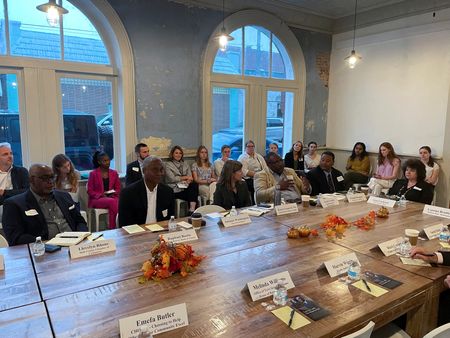By Howard Schneider
GREENSBORO, Alabama (Reuters) – The community roundtable was organized as a chance for Atlanta Federal Reserve President Raphael Bostic to hear how a town in the heart of the western Alabama Black Belt approached chronic problems like population loss, housing, and the challenge of creating new jobs.
Curtis Travis, who represents the area in the state legislature, had a different topic in mind: Interest rates.
The Fed’s rapid rate increases – the fastest in a generation – may be a logical response to high inflation, Travis told Bostic at the session last month, but it was putting small businesses and families reliant on credit in a bind, and if a recession resulted that would be worse for his constituents than rising prices.
“Inflation is bad, but the interest rates are also bad,” he told Bostic, elaborating in a later interview that he thinks families in this rural area could cope more easily with higher prices than with rising unemployment. The local unemployment rate is already nearly a percentage point above the U.S. average of 3.5%.
“In this area things are just beginning to improve,” he said. “All of a sudden you get a recession? Right now you can kind of adjust. It is easier to do than if you have no opportunity. I can make a decision not to buy a television… I understand what they are trying to do, but it is too quick.”
It was not the conversation Bostic was expecting, but it is one that the Fed may increasingly confront as the impact of its aggressive rate increases hit home.
“It’s very premature in my view to think about or be talking about pausing our rate hikes. We have a ways to go,” Fed Chair Jerome Powell said Wednesday. The greater mistake would be to stop too soon and allow inflation to become entrenched, which he argued would ultimately do more harm to lower-income households.
Powell’s remarks came after policymakers approved their fourth consecutive three-quarter-percentage-point rate increase, the fastest run-up in the U.S. central bank’s policy rate since 1981. The target federal funds rate is now in a range of between 3.75% and 4%, the highest since early 2008.
Though officials signaled they may be ready to temper further rate hikes, the pace and degree of the Fed’s actions have raised concerns far beyond one rural Alabama legislative district.
Inflation remains a top of mind concern, with nearly a third of respondents in a recent Reuters-Ipsos poll citing it as the most important problem facing the country, double the share concerned about unemployment and jobs. A Pew Research Center survey conducted Oct. 10-16 found more than 90% of respondents either very or somewhat concerned about rising prices.
Yet people are also becoming worried about the cure as well as the disease.
In the 1970s and 1980s, Fed Chair Paul Volcker’s attack on inflation sparked a recession that pushed the unemployment rate above 10%, then a post-World War II high. Volcker’s medicine was an order stricter than Powell’s – at one point the target Federal Funds rate neared 20%, and the interest rate on a 30-year home mortgage topped 18%.
But the 7% rate on a home mortgage now is the highest in 20 years, and the intensity of the Fed’s policy shift has raised concerns that, like Volcker, the Fed may trigger a downturn in the drive to tame prices.
FEAR OF THE CONSEQUENCES
Democratic lawmakers, including Ohio Democrat Sherrod Brown, the chair of the Senate Banking Committee that oversees the Fed, wrote to Powell in separate letters recently urging him to lay off.
“We must avoid having our short-term advances and strong labor market overwhelmed by the consequences of aggressive monetary actions to decrease inflation,” Brown wrote just ahead of midterm elections in which economic issues have been a key Republican campaign point against Democrats.
Brown’s argument, however, has gotten only slight purchase at the Fed, where opinion remains firm that the larger risk to the economy is not recession or a rise in unemployment, but inflation that becomes entrenched above its 2% target.
“I do worry about how rates affect the economy,” Bostic said at the forum. “Inflation is worse.”
He went on: “Stable prices in the broader economy are foundational” to sustainable levels of employment and growth.
The issue is just how much of a gash in the real economy the Fed will need to make along the way to a more sustainable, inflation-free expansion.
If, as some economists argue, prices are being driven more by forces like commodity shocks stemming from the war in Ukraine, drought across agricultural areas, ongoing supply difficulties, or even aggressive company markups, it may be beyond the Fed’s reach, absent a deep downturn that guts demand, and, in the process, jobs.”They should stop and see how it plays out,” while also explaining that inflation is likely to remain above 2% for some time because of the global forces pushing prices higher, said William Spriggs, a Howard University economics professor and chief economist of the AFL-CIO labor union.
Spriggs said he felt the Fed’s rhetoric has backed policymakers into a corner.
“When unemployment starts going up, you have not given yourself an out,” if inflation remains high, he said.
So far that worst-of-both-worlds combination has not developed.
Inflation has not moved much since the Fed began raising interest rates.
But neither has employment given way.
SOFT-LANDING INTACT?
The number of job vacancies unexpectedly rose in September, and an October employment report to be released Friday is expected to show the economy added around 200,000 positions during the month, still above the average of 183,000 seen in the decade from 2010 to 2019.
Data from payroll provider UKG showed activity among its sample of 4 million mostly hourly workers fell about 1% from September to October, evidence of what company vice president Dave Gilbertson said may be a modest slowdown in hiring but still in line with a “soft landing” for the Fed.
“Cracks are starting to emerge,” Gilbertson said, noting a more than 2% drop in manufacturing shifts. But “the overall theme… is that the soft landing is still intact.”
Even in housing, a key part of the economy battered by high mortgage rates, the closely related construction industry has yet to surrender jobs, stiffening the nerve of Fed policymakers to press on with rate increases, though as Bostic said they may have some explaining to do.
“I don’t think most people have in their minds the notion that stable prices are helpful for everyone. And in more rural places where they are used to just being whipsawed I think we have not made as strong of a case,” Bostic said. But, “we cannot solve every problem… We have to stay focused on the things that are most important, and at this point it is getting inflation so that it is not front and center in everyone’s mind.”
(Reporting by Howard Schneider; Editing by Dan Burns and Suzanne Goldenberg)


